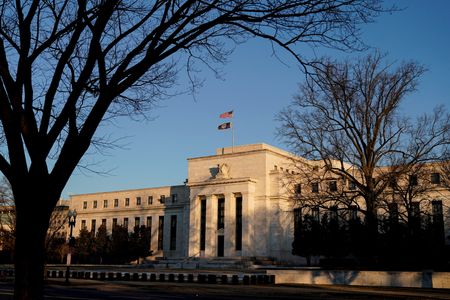
(Reuters) -Federal Reserve officials in March “generally agreed” to cut up to $95 billion a month from the central bank’s asset holdings as another tool in the fight against surging inflation, even as the war in Ukraine tempered the first U.S. interest rate increase.
Minutes of the Fed’s March 15-16 meeting showed policymakers rallying around plans to cut the central bank’s massive balance sheet as soon as next month, with reductions of up to $60 billion per month in its holdings of Treasury bonds and $35 billion in its stash of mortgage-backed securities (MBS), with the amounts phased in over three months or slightly longer.
That is nearly double the pace of the Fed’s “quantitative tightening” from 2017 to 2019. The more aggressive balance-sheet rundown, which should have the affect of increasing long-term interest rates, could also include outright sales of MBS down the road, said the minutes, which were released on Wednesday.
“All participants agreed that elevated inflation and tight labor market conditions warranted commencement of balance sheet runoff,” the minutes said, with participants saying enough progress had been made to begin trimming the Fed’s portfolio “after the conclusion of the upcoming meeting” on May 3-4.
But the rush to tighten monetary policy, in light of inflation currently running at triple the Fed’s 2% target, was still held back by the outbreak of war in Ukraine last month and the economic uncertainty it created.
The Fed raised its policy rate by a quarter of a percentage point at the meeting last month. Some policymakers were leaning towards a larger increase, but “in light of greater near-term uncertainty associated with Russia’s invasion of Ukraine, they judged that a 25-basis-point increase would be appropriate at this meeting,” the minutes said.
The Fed officials, however, left the door open for meatier increases in borrowing costs to come.
“Many participants noted that one or more 50-basis-point increases in the target range could be appropriate at future meetings, particularly if inflation pressures remained elevated or intensified,” the minutes stated.
SWOLLEN BALANCE SHEET
The details of the balance sheet program included in the minutes are in line with analysts’ expectations, and pave the way for it to be approved and set in motion next month.
The Fed began a massive bond-buying program in the spring of 2020 to help blunt the economic impact of the coronavirus pandemic, swelling its holdings of Treasuries and MBS from $3.8 trillion to $8.5 trillion.
No final decision on the run-off was made at last month’s policy meeting, the minutes said, but officials made “substantial progress” and could “begin the process” early next month, according to the minutes.
Yields on U.S. Treasury securities ticked higher after the release of the minutes, with the 10-year note yield climbing above 2.6%, while the dollar rose to its highest level since late May against a basket of currencies. Major U.S. stock indexes were poised to close the session sharply lower.
“I don’t think there’s anything material that would garner a change in sentiment, as opposed to yesterday where there was a real change and I think it really spooked investors,” said Alan Lancz, president of Alan B. Lancz and Associates in Toledo, Ohio, referring to comments made by Fed Governor Lael Brainard on Tuesday.
Brainard told a Minneapolis Fed conference that she expected a combination of interest rate increases and a rapid balance sheet runoff to bring U.S. monetary policy to a “more neutral position” later this year, with further tightening to follow as needed.
(Reporting by Howard SchneiderEditing by Paul Simao)

